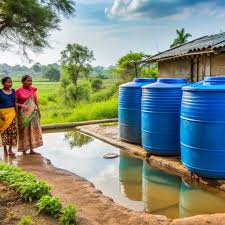Water is the foundation of life, yet access to clean and reliable water remains a challenge in many rural parts of India. As climate change, population growth, and unsustainable practices put increasing pressure on this precious resource, innovative solutions are emerging across the country. These water conservation innovations are not only improving daily life but also ensuring long-term sustainability for farming, livelihoods, and communities.
1. Rainwater Harvesting Revival
Rainwater harvesting isn’t new to India, but modern techniques are making it more effective. Rural schools, homes, and community buildings are now equipped with rooftop harvesting systems that store rainwater in underground tanks, ensuring water availability during dry months.
2. Check Dams and Percolation Tanks
Low-cost, community-built check dams and percolation tanks are being used to trap rainwater runoff. These small structures help recharge groundwater, control soil erosion, and maintain moisture levels in surrounding farmlands.
3. Drip Irrigation and Micro-Irrigation Systems
To combat the overuse of water in agriculture, farmers are switching to drip irrigation and sprinkler systems. These innovations reduce water waste by delivering water directly to plant roots, increasing crop yield while conserving water.
4. Pani Panchayats and Community Governance
Innovative social structures like Pani Panchayats (Water Councils) empower rural communities to manage their water resources collectively. These democratic bodies oversee usage, maintenance, and conflict resolution, ensuring equitable access for all.
5. Use of Remote Sensing and IoT
Some villages are adopting smart technologies such as sensors, drones, and IoT-based water meters to monitor groundwater levels, track usage patterns, and detect leaks. These tools offer data-driven insights that help in better water management.
6. Recycled Greywater for Agriculture
Recycling household wastewater (greywater) from kitchens and bathrooms is an emerging practice. Simple filtration units allow this water to be reused for irrigating crops and gardens, reducing freshwater consumption.
7. Contour Bunding and Land Management
In hilly and drought-prone areas, techniques like contour bunding—creating ridges across slopes—are used to slow down water flow, prevent runoff, and increase soil moisture. This method is especially helpful in recharging aquifers.
8. Awareness Through Grassroots Campaigns
NGOs, schools, and local leaders are spreading awareness through workshops, murals, and storytelling. Campaigns like “Jal Shakti Abhiyan” have mobilized thousands to adopt water-saving habits and revive dying water bodies.
Real Success Stories
- Hiware Bazar, Maharashtra: Once a drought-hit village, Hiware Bazar became water-sufficient through rainwater harvesting, watershed development, and community involvement.
- Ralegan Siddhi, Maharashtra: Under the guidance of Anna Hazare, the village transformed its water resources using check dams and bans on water-intensive crops.
Conclusion
Rural India is proving that sustainable innovation doesn’t always require high-tech solutions—it needs community participation, awareness, and the right blend of traditional wisdom and modern tools. With more regions adopting these practices, water conservation in rural India is becoming a movement that promises a secure and resilient future.
































































